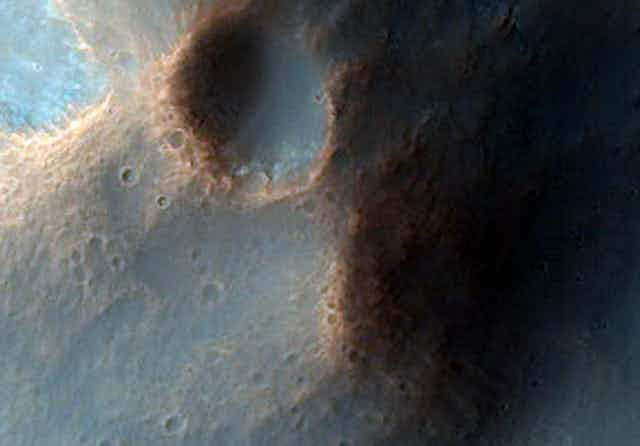Our interest in our near-neighbour Mars – the hope of finding life there, or of possibly colonising it in the future – has driven several orbiting missions to the planet. These produced very detailed maps of the surface and investigated the Martian atmosphere. Three robotic missions have used rovers to get information about composition of Martian surface materials, such as rocks and soils.
And on top of that, significant amounts of information about Mars comes from a specific group of meteorites originating from the surface of the planet. These have been launched into space by impacts, eventually reaching Earth and falling to its surface. We have just published research looking at one of these meteorites, and it has revealed a great deal about the history of Mars.
Strangely enough, all Martian meteorites identified until just a few years ago came from the northern hemisphere of the planet, which is topographically lower than and compositionally different to the southern hemisphere. As a result, these meteorites give a very one-sided view of the planet.
About two years ago, four stones, probably from the same meteorite, were discovered in the Sahara desert. The initial studies of their mineralogy, petrology and composition showed they are from Mars, but are very different to all previously discovered Martian samples.
In fact, rather than representing a single rock they are composed of different rock and soil fragments welded together by the impacts that hit the Martian surface in the past. Chemical composition of the samples also indicates that they contain a high proportion of meteoritic component and represent pieces of Martian surface where rocks and soils have been disturbed by impacts, fragmented and mixed together.
This gives us a glimpse of the diversity of Martian history. Every new piece of information extracted from these samples gives new clues about the planet.
The chemistry of these rocks suggests the meteorites originated from the previously unsampled southern hemisphere of Mars.

There are fine-grained clasts – rocks made from fragments of other rocks – in the samples that are chemically similar to Martian soil analysed by the rovers. MSL (Mars Science Laboratory) Curiosity is currently studying the mineral make up of modern Martian soil. The coincidence of finding a sample where we can examine the (ancient) soil in the lab is remarkable.
We experimented with this soil, finding it rich in magnetic minerals. It is oxidised, and this happened early, so we know that Mars has been a red planet at least since 1.7 billion years ago and probably earlier.
It lacks the sulfur, chlorine and zinc enrichments seen in modern Martian soil. These are water soluble elements, so perhaps this is what we expect of a wet, early Mars. The soil of today’s dry Mars (drier than the Sahara desert) got these element enrichments because of the complete drying up of the planet’s accessible water.
There are also zircons in the samples. Zircon is a common mineral in the rocks that build up the continental crust on Earth, but this is the first zircon find on Mars. It tells us that Mars had a complex magmatic history – there was a lot of melting of its rocks. Crystallisation of zircon requires a complicated series of melting and re-melting of rocks on the large (perhaps planetary) scale.
In addition, zircon is one of the most heavily used geochronometers: it tells us the age of samples. Very small concentrations of uranium and lead allow researchers to precisely determine the time of crystallisation of this mineral. And Martian zircons are old; older than 4.4 billion years.
This suggests that all the complexity of processes and magmatism on Mars occurred very early in the history of the planet: just a little bit more than 100m years after the formation of the solar system.
It also indicates the first differentiated rocks on Mars formed concurrently with the oldest crust on Earth and the moon. The first rock from the Martian highlands easily yielded some of the oldest ages returned from any planetary body.
These few recently found pieces of Martian crust – with total weight less than half a kilogram – have already given us a lot of information about the Red Planet. There is more to come in the future as these samples are complex assemblages of different rock fragments, all with a slightly different history and all adding a piece to our understanding of Mars.

